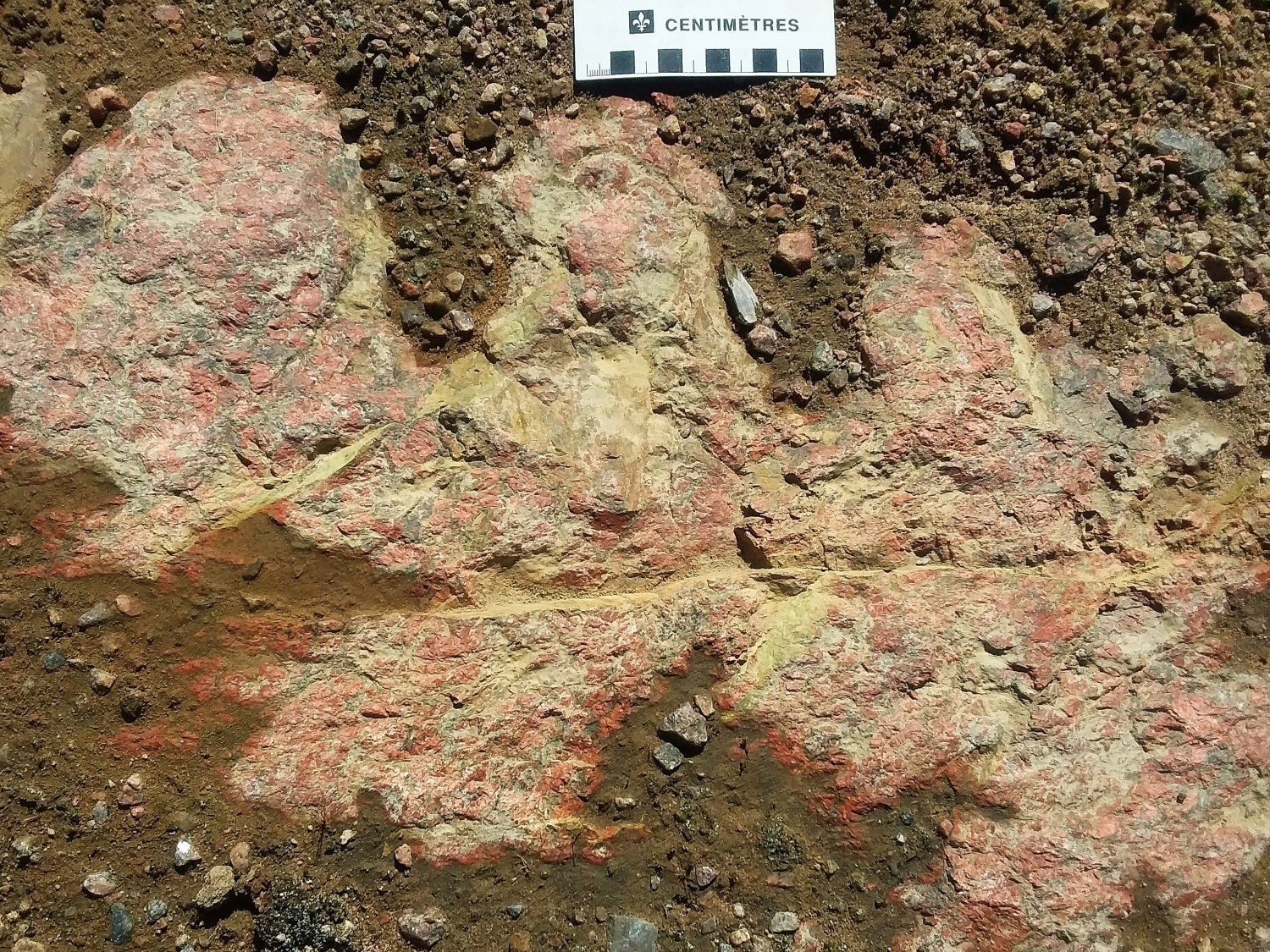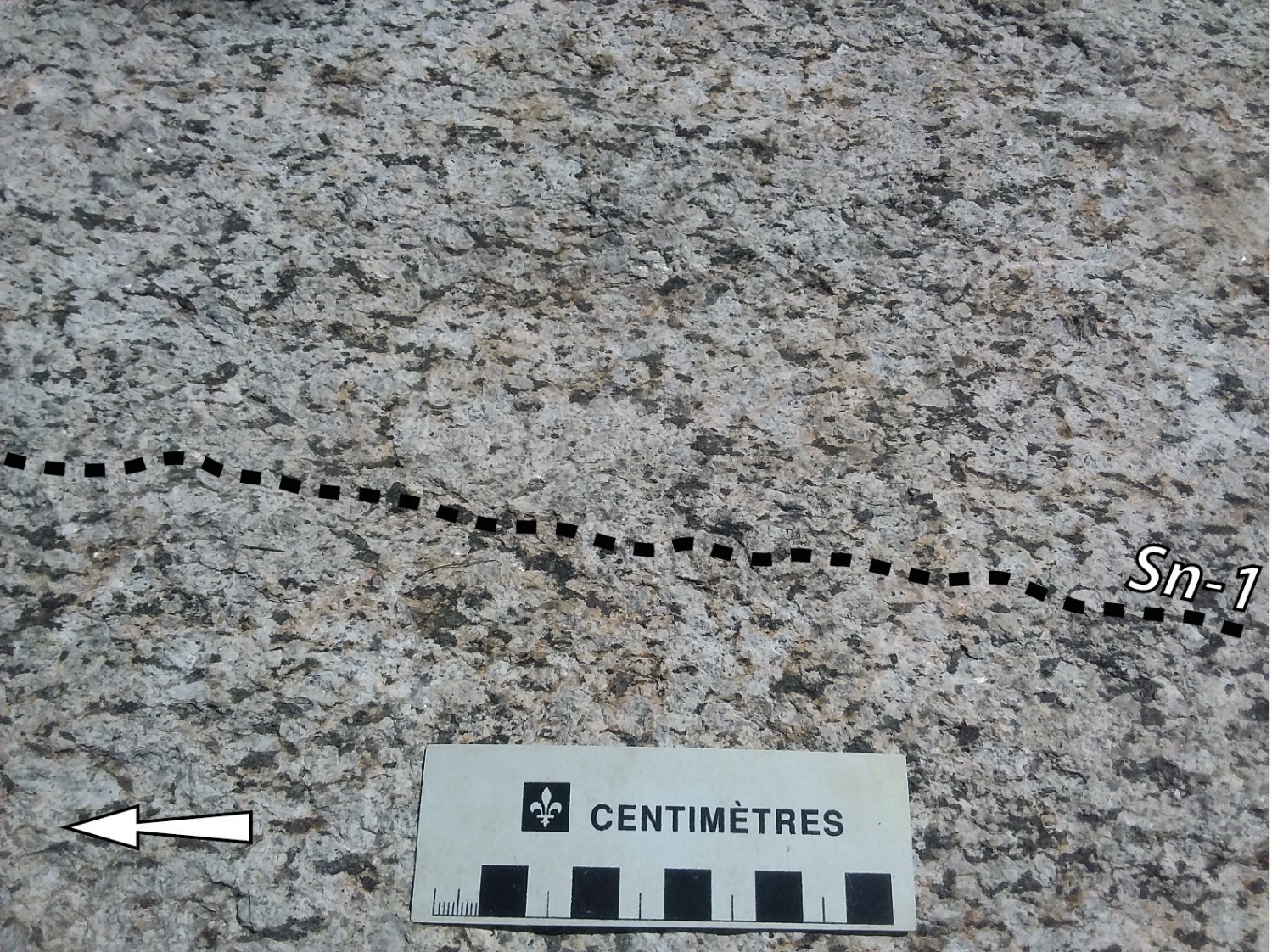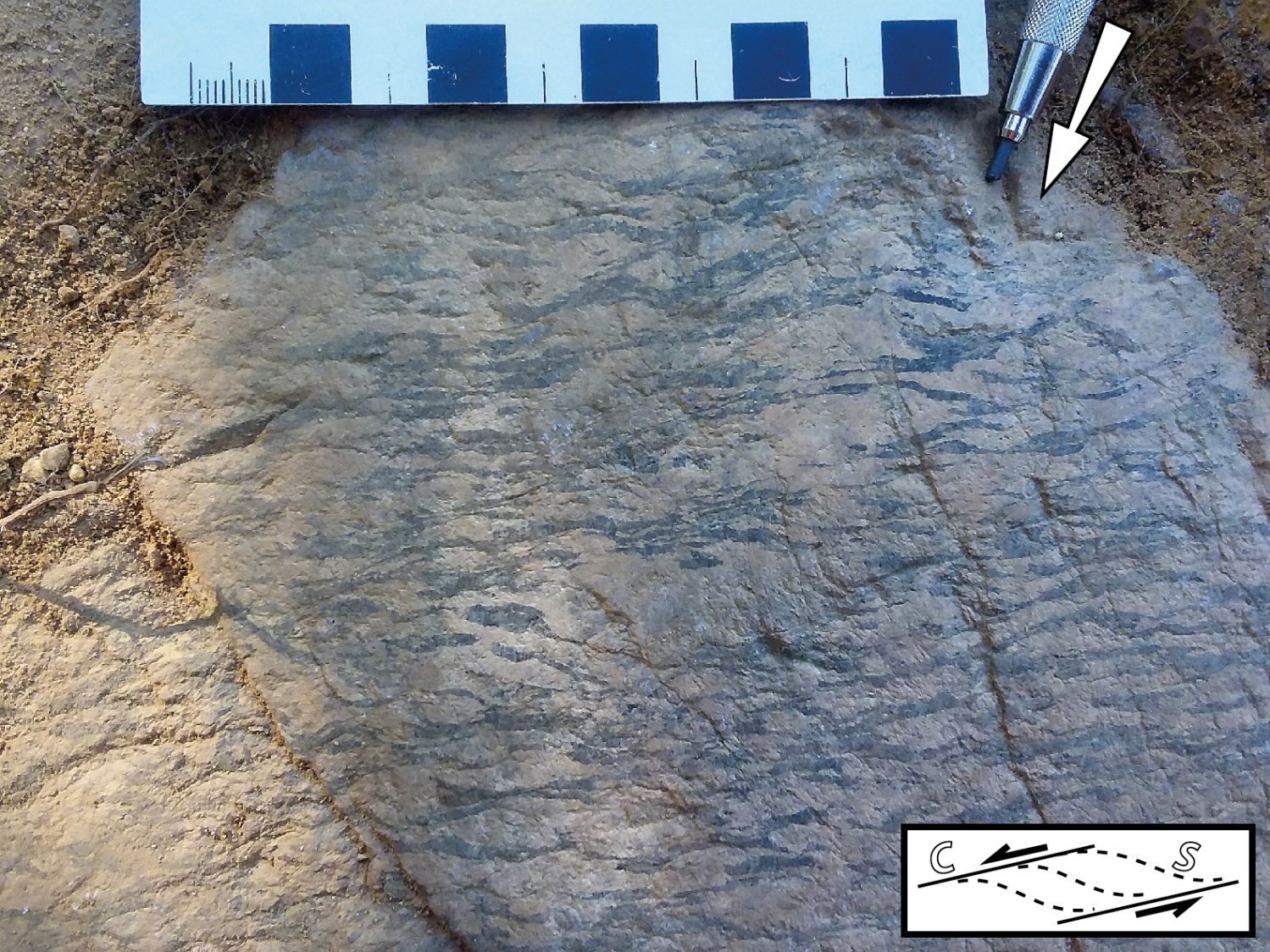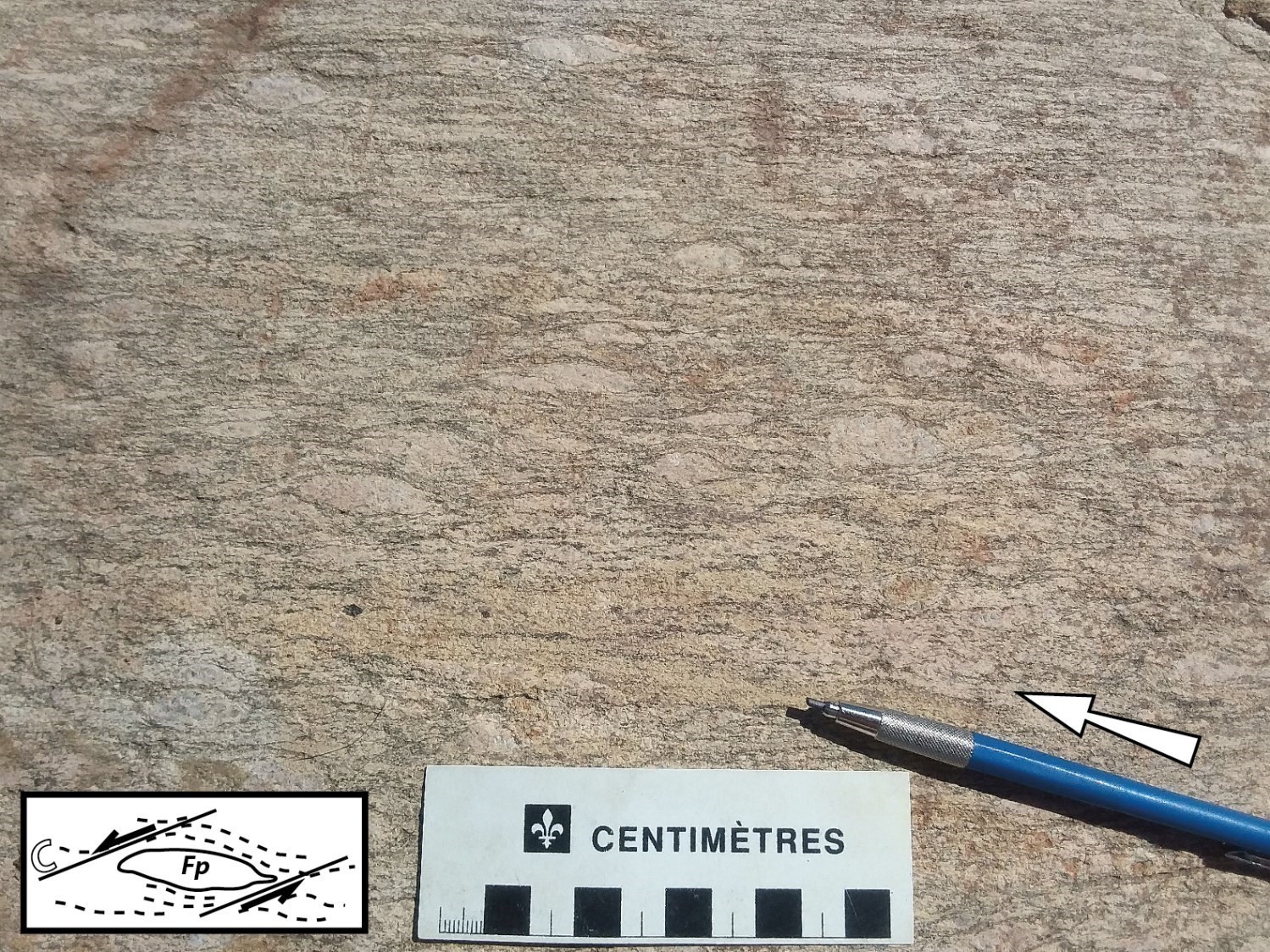
| Author(s) | Moukhsil and Daoudene, 2019 |
| Methodology | Defined from geological survey |
| Geological(s) subdivision(s) | Grenville Province / Allochton |
| Main movement | Sinistral |
| Deformation style | Anastomosed |
| Metamorphic facies (mean facies related to main deformation) | Lower amphibolites |
Background and Methodology
The Saint-François-de-Sales Shear Zone was defined following geological mapping surveys conducted in the Commissaires Lake area by Moukhsil and Daoudene (2019).
Boundaries and Morphology
| Width | Between 6 and 14 km |
| Length | Minimum of ~56 km |
| Orientation | N-S |
The Saint-François-de-Sales Shear Zone occurs as an N-S oriented strip, 6 to 14 km wide and ~56 km long in NTS sheets 32A01 and 32A08. The shear zone affects Mesoproterozoic units of the Grenville Province Allochton. It appears to be continuing southward in sheet 31P16 and northward in sheet 32A09. In the latter case, it is partially masked by overlying unformed Ordovician sedimentary units of the Lac-Saint-Jean Structural Domain. The Saint-François-de-Sales Shear Zone borders the Saint-André-du-Lac-Saint-Jean Structural Domain to the east. Finally, it delineates the Bouchette and Commissaires structural domains to the west.
Stratigraphic Units Concerned
The stratigraphic units present in the Saint-François-de-Sales Shear Zone are:
– Montauban Group (mPmt5);
– Belley Plutonic Suite (mPbly3 and mPbly4);
– Wabash Complex (mPwab1);
– Travers Suite (mPtra2, mPtra3 and mPtra4);
– Lachance Mangerite (mPlhc);
– Ouiatchouan Anorthositic Suite (mPoch2).
Structural Characteristics
In sheets 32A01 and 32A08, most outcrops of the Saint-François-de-Sales Shear Zone show very varied structural fabrics (foliation, lineation, shear bands, etc.) that appear to be associated with at least two distinct deformation phases. Early structural fabrics appear to have developed under high-grade metamorphic conditions, while the most recent ones, those associated with the most deformed zones (see below), have developed under lower grade metamorphic conditions. It is the Sn foliation of this second event that defines the structural grain of the Saint-François-de-Sales Shear Zone. Regionally, the first foliation denoted here Sn-1 appears, in terms of orientation, usually transposed to Sn. Unlike neighbouring structural domains where Sn corresponds to the S2 regional foliation, here the Sn foliation appears to correspond to a very late Grenvillian deformation phase (see “Metamorphic Characteristics” section below, as well as Moukhsil and Daoudene, 2019). In this model, the Sn-1 fabric would represent either the expression of the S2 regional foliation or a S2-S3 composite foliation.
❯ Main Fabrics

 The structure of the Saint-François-de-Sales Shear Zone is characterized by a network of intensely deformed rock strips. These strips are anastomosed, metre to hectometre thick and straight at the outcrop scale. Rocks are characterized by high grain size reduction, mainly accommodated by ductile dynamic recrystallization processes, but also by less fracturing. Some of the broadest strips are characterized by mylonitic banding of centimetric to decimetric bands, in which grain size reduction is variable but quantifiable by the percentage of remaining porphyroclasts. Some bands have >90% porphyroclasts (protomylonite), most contain 10 to 90% (mylonite), and some <10% (ultramylonite). In addition to the strong orientation of ferromagnesian mineral clusters, if present, mylonites commonly show quasimonomineralic banding (alternating quartz and feldspar bands) in thin section, and generally strong flattening of quartz or feldspar grains. Some deformation corridors within the Saint-François-de-Sales Shear Zone are especially marked by the presence of cataclasites in which there are numerous slickensides.
The structure of the Saint-François-de-Sales Shear Zone is characterized by a network of intensely deformed rock strips. These strips are anastomosed, metre to hectometre thick and straight at the outcrop scale. Rocks are characterized by high grain size reduction, mainly accommodated by ductile dynamic recrystallization processes, but also by less fracturing. Some of the broadest strips are characterized by mylonitic banding of centimetric to decimetric bands, in which grain size reduction is variable but quantifiable by the percentage of remaining porphyroclasts. Some bands have >90% porphyroclasts (protomylonite), most contain 10 to 90% (mylonite), and some <10% (ultramylonite). In addition to the strong orientation of ferromagnesian mineral clusters, if present, mylonites commonly show quasimonomineralic banding (alternating quartz and feldspar bands) in thin section, and generally strong flattening of quartz or feldspar grains. Some deformation corridors within the Saint-François-de-Sales Shear Zone are especially marked by the presence of cataclasites in which there are numerous slickensides.
In sheets 32A01 and 32A08 and at the scale of the St-François-de-Sales Shear Zone, the Sn mylonitic foliation is overall oriented NNE-SSW. In contrast, the direction of the largest slope line is more variable, although the vast majority of measurements show a moderate (45-55°) eastward dip.
 The mylonitic foliation carries a mineral and stretch lineation Ln, generally very well marked. The stereographic projection of measurements from sheets 32A01 and 32A08 shows very shallow plunges towards the NNE or SSW. This feature clearly indicates that the Dn deformation is primarily associated with strike-slip kinematics.
The mylonitic foliation carries a mineral and stretch lineation Ln, generally very well marked. The stereographic projection of measurements from sheets 32A01 and 32A08 shows very shallow plunges towards the NNE or SSW. This feature clearly indicates that the Dn deformation is primarily associated with strike-slip kinematics.
| Main Fabric | Type of Fabric | Direction (°) | Dip (°) | Number of Measurements | Comments |
| Foliation Sn | Mylonitic foliation or banding | 13 | 47 | 19 | – |
| Lineation Ln | Mineral and stretch lineation | N-S to NNE-SSW | Shallow | 13 |
Plunge measurements at 0° were excluded from analytical treatment |
The Saint-François-de-Sales Shear Zone hosts a kilometric intrusion called the Lachance Mangerite. This intrusion is oval and its long axis is oriented N-S, parallel to the shear zone general orientation. Due to lack of outcrops, a limited number of foliation measurements are available in this intrusion. However, the foliation trajectory, drawn from field data and magnetic lineaments, shows a concentric pattern that follows the form of the intrusion. At the same time, measured foliation planes generally have a moderate to strong dip towards the centre of the intrusion. This suggests that the Lachance Mangerite has a bowl form.
❯ Other Fabrics
Mylonite strips of the Saint-François-de-Sales Shear Zone delineate kilometric lens blocks within which deformation generally indicates low to medium intensity. In these blocks, the main fabric is a Sn-1 diffuse foliation with no well-defined plane, and essentially marked by the preferential orientation of ferromagnesian minerals (biotite, amphibole and pyroxene). All stratigraphic units of the shear zone are affected by this foliation to varying degrees. In terms of orientation, the numerous measurements collected in sheets 32A01 and 32A08 show that the Sn-1 foliation is commonly oriented NNE-SSW. In addition, most measurements show moderate to steep SE dips. At the shear zone scale, the Sn-1 foliation is mapped (or nearly so) to the Sn mylonitic foliation of intense deformation corridors.
The Sn-1 foliation carries an Ln-1 mineral and stretch lineation having a highly variable attitude. Of the few measurements collected in sheets 32A01 and 32A08, one group is characterized by a steep plunge in lineation (~63°).
| Main Fabric | Type of fabric | Direction (°) | Dip (°) | Number of Measurements | Comments |
| Foliation Sn-1 | Secondary tectonometamorphic foliation, gneissosity | 16 | 44 | 142 | The vast majority of measurements dip eastward. |
| Lineation Ln-1 | Mineral and stretch lineation | 67 | 63 | 23 | Very variable, but a group distributed around the average lineation (67.63) prevails. |
❯ Folds
Not observed.
❯ Crosscutting Relationships
The analysis of magnetic imaging in sheets 32A01 and 32A08 suggests that the Saint-François-de-Sales Shear Zone is cut by a number of faults which, in terms of orientation, are divided into three families.
Geometric Parameters of Regional Faults Cutting the Saint-François-de-Sales Shear Zone:
| Fault or Family of Faults | Type | Mean Direction (°) | Mean Dip (°) | Lineation Plunge in the Fault Plane | Estimated Width (m) | Estimated Length (km) | Apparent Movement | Position | Comments |
| Family of NNW-SSE faults | Regional fault | NNW-SSE | ~90 | – | – | ~8 | Dextral | Interpretation based on geophysical surveys | Interpreted in the southern portion of sheet 32A01 |
| WNW-ESE fault | Regional fault | WNW-ESE | ~90 | – | – | 11 | Dextral | Interpretation based on geophysical surveys | Interpreted in the southern portion of sheet 32A01 |
| Family of NW-SE faults | Regional fault | NW-SE | ~90 | – | – | 3-13 | Sinistral | Interpretation based on geophysical surveys | Interpreted in the northern portion of sheet 32A08 |
❯ Kinematics
Several kinematic indicators can be observed in Dn mylonitic deformation strips of the Saint-François-de-Sales Shear zone. These are mainly C/S structures of sheared rocks, but also local shear bands, sigma or delta-type porphyroclasts, drag folds and rotated objects. To date, all kinematic criteria measured in the shear zone have been observed in sheets 32A01 and 32A08. The majority of these movement indicators clearly show apparent kinematics that are mainly sinistral. These criteria are associated with shear planes, often subparallel to the Sn mylonitic foliation. The mean direction of these planes is N-S and their plunge is generally moderate to the east. The associated mineral and stretch lineations are slightly plunging to the NNE. Nevertheless, some indicators of apparent dextral movement were observed, involving shear planes with a mean orientation of ~50° and a steep SE plunge (65°). The obliquity between the two shear planes suggests that they are two conjugate shear directions.
| Type | Direction (°) (mean) | Dip(°) (mean) | Lineation Plunge in the Fault Plane | Apparent Movement | Kinematic Indicators | Comments |
| Regional shearing | 1 | 59 | Mean mineral and stretch lineations with 9° plunge in the 17° direction | Sinistral | C/S-type fabric, sigma-type porphyroblasts, shear bands | 16 macroscopic kinematic criteria |
| Regional shearing | 50 | 65 | Mineral and stretch lineations plunging towards the NE or SW at an angle between 15° and 57° | Dextral | C/S-type fabric, objects or planes folded by shearing | Only three macroscopic kinematic criteria. This could be a conjugate shear direction with the main direction, as documented above. |
Deformation Style
The deformation style of the Saint-François-de-Sales Shear Zone is heterogeneous and dominated by an anastomosed network of metric to hectometric strips of intense deformation, as evidenced by the presence of mylonites and cataclasites. These strips, which appear to be associated with a late Dn deformation dominated by a N-S sinistral strike-slip kinematics, delineate lenticular blocks in which rocks have generally undergone mild to moderate deformation.
Metamorphic Characteristics
In order to clarify metamorphic conditions associated with deformation in the Saint-François-de-Sales Shear Zone, ~15 samples from representative rocks were studied as thin sections. These analyses show that the deformation observed within this shear zone is quite heterogeneous in terms of metamorphic conditions.
Samples from mylonite zones, whose development is attributed to the Dn deformation phase, show structural characteristics associated with retrogressive metamorphic conditions from the amphibolite facies to the greenschist facies. In fact, intrusive quartzofeldspathic rocks frequently contain feldspar porphyroclasts whose edges have finely recrystallized by subgrain rotation or budding of new grains. This dynamic recrystallization at grain edges gives porphyroclasts a core-and-mantle texture, typical of temperatures associated with a medium metamorphic grade (450-600°C, Passchier and Trouw, 2005). The ductile character of the deformation of feldspar porphyroclasts could also be seen in their cores, which generally have undulatory extinction. Outside feldspar porphyroclasts, quartz grains show dynamic recrystallization dominated by subgrain rotation, suggesting a deformation temperature in the range of the lower amphibolite facies (400-500°C, Passchier and Trouw, 2005). However, feldspar porphyroclasts (and in some cases whole rocks) are cut by fractures that indicate a brittle and rather late deformation. In outcrop, the recognition of cataclasites supports the interpretation of the greenschist facies retrogressive character of the Dn deformation.
Outside the most deformed zones of the Saint-François-de-Sales Shear Zone, felsic to intermediate intrusive rocks locally show quartz-plagioclase-K-feldspar-orthopyroxene-biotite-hornblende mineralogical assemblages. This suggests that these rocks have been affected by upper amphibolite or granulite facies metamorphic conditions.
Alterations
Mylonite strips of the Saint-François-de-Sales Shear Zone frequently show strong hematitization and chloritization. Some ultramylonite strips are even characterized by alternating centimetric to decimetric greenish-altered, chlorite-rich bands, and other rather reddish, highly hematitized ones. Cataclastic facies show the same type of alteration, with rock fragments generally highly hematitized in a dark chlorite-rich matrix.
Geophysical Characteristics
In sheets 32A01 and 32A08, with the exception of the Lachance Mangerite distribution area, the Saint-François-de-Sales Shear Zone shows a fairly homogeneous domain-wide signal on the magnetic field map and its derivatives (Intissar and Benahmed, 2015). On the magnetic field vertical gradient map, the pattern is characterized by a sequence of more or less continuous N-S strips that are very magnetic, separating a domain of low magnetic susceptibility. The Lachance Mangerite shows a granular magnetic pattern with low to moderate susceptibility.
Chronological Markers
Structural characteristics of the Lachanche Mangerite (ovoid shape with a long N-S axis and concentric foliation) suggest that its emplacement is synchronous with the development of the Saint-François-de-Sales Shear Zone. Upcoming dating of a Lachance Mangerite sample (18-AM-125) should therefore allow for dating more precisely the Saint-François-de-Sales Shear Zone.
References
Publications available through Sigéom Examine
INTISSAR, R., BENAHMED, S. 2015. LEVE MAGNETIQUE AEROPORTE DANS LE SECTEUR OUEST DU LAC-ST-JEAN, PROVINCE DE GRENVILLE. MERN, GOLDAK AIRBORNE SURVEYS. DP 2015-06, 7 pages and 2 plans.
MORFIN, S., TREMBLAY, C., SOLGADI, F., MOUKHSIL, A., DAIGNEAULT, R. 2015. GEOLOGIE DE LA REGION DE CHAMBORD, ROBERVAL ET NOTRE-DAME-DE-LA-DORE (FEUILLETS SNRC 32A08, A09 ET A10) ET RECONNAISSANCE DES FEUILLETS 32A06, A07 ET A11. MERN, CERM. MB 2015-07, 69 pages and 5 plans.
MOUKHSIL, A., SOLGADI, F., BELKACIM, S., AUGLAND, L E., DAVID, J. 2015. GEOLOGIE DE LA REGION DE PARENT, HAUT-SAINT-MAURICE (PARTIE OUEST DU GRENVILLE). MERN, UQAT-URSTM, GEOTOP-UQAM-MCGILL. RG 2015-04, 62 pages and 1 plan.
MOUKHSIL, A., DAOUDENE, Y. 2019. Géologie de la région du lac des Commissaires, Province de Grenville, région du Saguenay–Lac-Saint-Jean, Québec, Canada. MERN. BG 2019-01.
Other publications
PASSCHIER, C.W., TROUW, R.A.J. 2005. Microtectonics, 2nd Edition. Springer, New York. doi:10.1007/3-540-29359-0.




